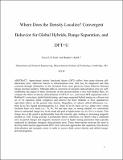| dc.contributor.author | Gani, Terry Zhi Hao | |
| dc.contributor.author | Kulik, Heather Janine | |
| dc.date.accessioned | 2017-12-01T15:08:38Z | |
| dc.date.available | 2017-12-01T15:08:38Z | |
| dc.date.issued | 2016-11 | |
| dc.date.submitted | 2016-09 | |
| dc.identifier.issn | 1549-9618 | |
| dc.identifier.issn | 1549-9626 | |
| dc.identifier.uri | http://hdl.handle.net/1721.1/112334 | |
| dc.description.abstract | Approximate density functional theory (DFT) suffers from many-electron self-interaction error, otherwise known as delocalization error, that may be diagnosed and then corrected through elimination of the deviation from exact piecewise linear behavior between integer electron numbers. Although paths to correction of energetic delocalization error are well-established, the impact of these corrections on the electron density is less well-studied. Here, we compare the effect on density delocalization of DFT+U (i.e., semilocal DFT augmented with a Hubbard U correction), global hybrid tuning, and range-separated hybrid tuning on a diverse test set of 32 transition metal complexes and observe the three methods to have qualitatively equivalent effects on the ground state density. Regardless of valence orbital diffuseness (i.e., from 2p to 5p), ligand electronegativity (i.e., from Al to O), basis set (i.e., plane wave versus localized basis set), metal (i.e., Ti, Fe, Ni), and spin state, or tuning method, we consistently observe substantial charge loss at the metal and gain at ligand atoms (∼0.3–0.5 e or more). This charge loss at the metal is preferentially from the minority spin, leading to increasing magnetic moment as well. Using accurate wave function theory references, we observe that a minimum error in partial charges and magnetic moments occurs at higher tuning parameters than typically employed to eliminate energetic delocalization error. These observations motivate the need to develop multifaceted approximate-DFT error correction approaches that separately treat density delocalization and energetic errors to recover both correct density and orbital energy-derived properties. | en_US |
| dc.description.sponsorship | National Science Foundation (U.S.) (Grant ECCS-1449291) | en_US |
| dc.description.sponsorship | National Science Foundation (U.S.) (Grant ACI-1053575) | en_US |
| dc.language.iso | en_US | |
| dc.publisher | American Chemical Society (ACS) | en_US |
| dc.relation.isversionof | http://dx.doi.org/10.1021/acs.jctc.6b00937 | en_US |
| dc.rights | Article is made available in accordance with the publisher's policy and may be subject to US copyright law. Please refer to the publisher's site for terms of use. | en_US |
| dc.source | Prof. Kulik | en_US |
| dc.title | Where Does the Density Localize? Convergent Behavior for Global Hybrids, Range Separation, and DFT+U | en_US |
| dc.type | Article | en_US |
| dc.identifier.citation | Gani, Terry Z. H., and Kulik, Heather J. “Where Does the Density Localize? Convergent Behavior for Global Hybrids, Range Separation, and DFT+U.” Journal of Chemical Theory and Computation 12, 12 (December 2016): 5931–5945 © 2016 American Chemical Society | en_US |
| dc.contributor.department | Massachusetts Institute of Technology. Department of Chemical Engineering | en_US |
| dc.contributor.approver | Kulik, Heather J | en_US |
| dc.contributor.mitauthor | Gani, Terry Zhi Hao | |
| dc.contributor.mitauthor | Kulik, Heather Janine | |
| dc.relation.journal | Journal of Chemical Theory and Computation | en_US |
| dc.eprint.version | Author's final manuscript | en_US |
| dc.type.uri | http://purl.org/eprint/type/JournalArticle | en_US |
| eprint.status | http://purl.org/eprint/status/PeerReviewed | en_US |
| dspace.orderedauthors | Gani, Terry Z. H.; Kulik, Heather J. | en_US |
| dspace.embargo.terms | N | en_US |
| dc.identifier.orcid | https://orcid.org/0000-0003-0357-6390 | |
| dc.identifier.orcid | https://orcid.org/0000-0001-9342-0191 | |
| mit.license | PUBLISHER_POLICY | en_US |
| mit.metadata.status | Complete | |
